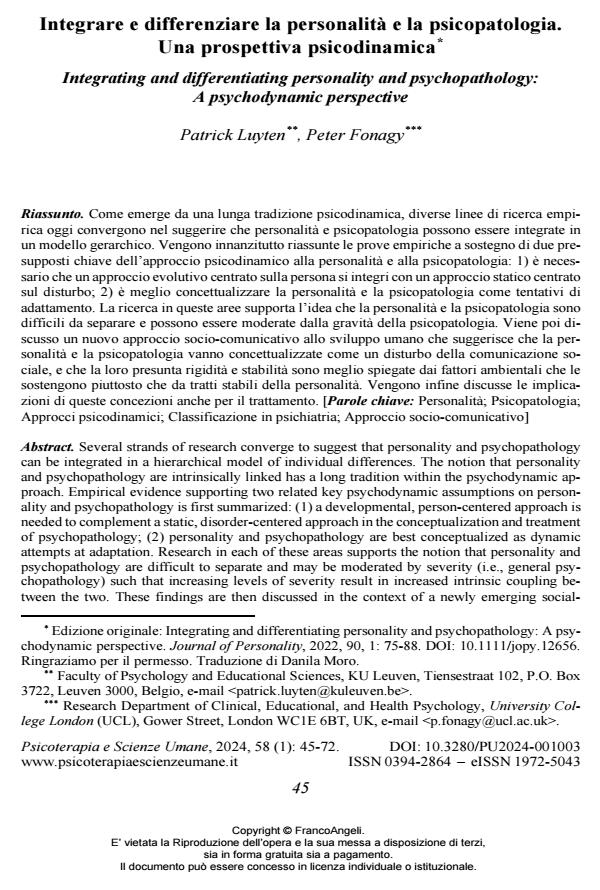Integrare e differenziare la personalità e la psicopatologia. Una prospettiva psicodinamica
Titolo Rivista PSICOTERAPIA E SCIENZE UMANE
Autori/Curatori Patrick Luyten, Peter Fonagy
Anno di pubblicazione 2024 Fascicolo 2024/1
Lingua Italiano Numero pagine 28 P. 45-72 Dimensione file 267 KB
DOI 10.3280/PU2024-001003
Il DOI è il codice a barre della proprietà intellettuale: per saperne di più
clicca qui
Qui sotto puoi vedere in anteprima la prima pagina di questo articolo.
Se questo articolo ti interessa, lo puoi acquistare (e scaricare in formato pdf) seguendo le facili indicazioni per acquistare il download credit. Acquista Download Credits per scaricare questo Articolo in formato PDF

FrancoAngeli è membro della Publishers International Linking Association, Inc (PILA)associazione indipendente e non profit per facilitare (attraverso i servizi tecnologici implementati da CrossRef.org) l’accesso degli studiosi ai contenuti digitali nelle pubblicazioni professionali e scientifiche
Come emerge da una lunga tradizione psicodinamica, diverse linee di ricerca empirica oggi convergono nel suggerire che personalità e psicopatologia possono essere integrate in un modello gerarchico. Vengono innanzitutto riassunte le prove empiriche a sostegno di due presupposti chiave dell’approccio psicodinamico alla personalità e alla psicopatologia: 1) è necessario che un approccio evolutivo centrato sulla persona si integri con un approccio statico centrato sul disturbo; 2) è meglio concettualizzare la personalità e la psicopatologia come tentativi di adattamento. La ricerca in queste aree supporta l’idea che la personalità e la psicopatologia sono difficili da separare e possono essere moderate dalla gravità della psicopatologia. Viene poi discusso un nuovo approccio socio-comunicativo allo sviluppo umano che suggerisce che la personalità e la psicopatologia vanno concettualizzate come un disturbo della comunicazione sociale, e che la loro presunta rigidità e stabilità sono meglio spiegate dai fattori ambientali che le sostengono piuttosto che da tratti stabili della personalità. Vengono infine discusse le implicazioni di queste concezioni anche per il trattamento.
Parole chiave:Personalità; Psicopatologia; Approcci psicodinamici; Classifi-cazione in psichiatria; Approccio socio-comunicativo
Patrick Luyten, Peter Fonagy, Integrare e differenziare la personalità e la psicopatologia. Una prospettiva psicodinamica in "PSICOTERAPIA E SCIENZE UMANE" 1/2024, pp 45-72, DOI: 10.3280/PU2024-001003